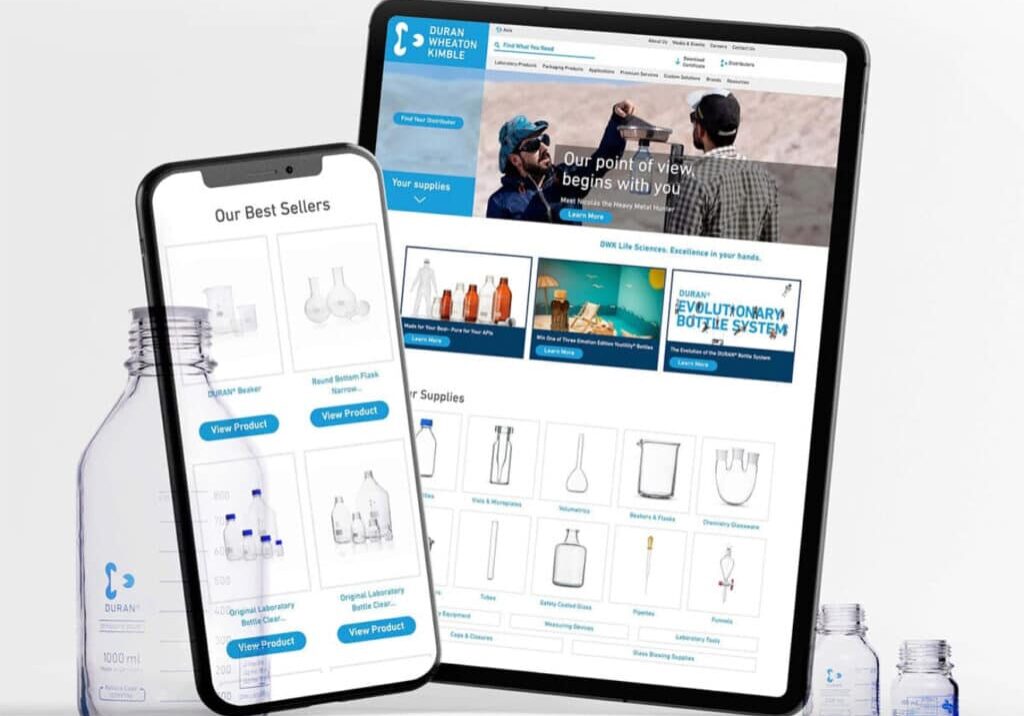Digital Strategy, SEO & Content Marketing, Website Design & UX
11 Minutes
5 Lessons I Learned from Working 24/7 With the Top Life Science Companies in 2017
In 2016, we discovered that 57% of life scientists use search engines as their #1 source for finding new products and services.
In 2017, we have seen adaptive life science companies, including ThermoFisher and Bio-Rad, respond to the market by increasing their budget for Search Engine Marketing by 300%-400% (see graphic below).
With 2018 coming around the corner, we wanted to reveal the 5 biggest lessons that we learned in 2017 from launching 27 websites, managing 23 AdWords accounts and optimizing for over 1050 keywords via SEO for our clients.
If you can take some wisdom from these trends we discovered in 2017, then you will be able to make sure your life science marketing strategy in 2018 is ready for the abundant opportunities for growth.
Lesson 1: The Big Guys Are Spending Millions on AdWords
Yes, you read that correctly!
Millions.
We have noticed that many of the “life science giants” are spending a lot more on AdWords than ever before.
But don’t take our word for it — here’s how much ThermoFisher and Bio-Rad are spending on AdWords. (Data courtesy of SEMRush).
ThermoFisher spending up over 400% from 2016
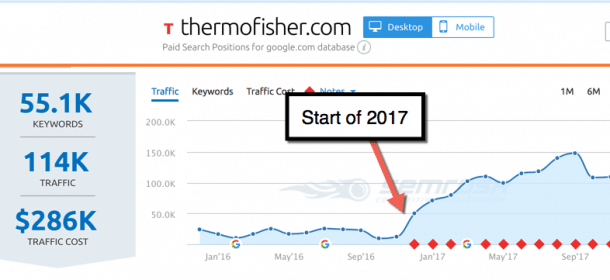
Bio-Rad spending up over 250% from 2016
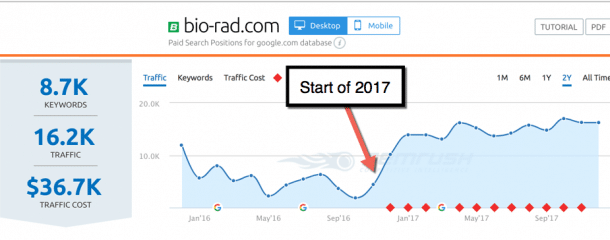
At least 70% of our AdWords accounts are now competing with ThermoFisher and other large companies like Bio-Rad.
The big question: WHY the huge investment in AdWords by major life science players?
Well, obviously it is because they are making a tremendous amount of money.
Also, it is easier than ever before to make money on AdWords with up to 55% of organic traffic shifting to paid traffic and paid ads looking almost indistinguishable from organic results.
Most importantly, these companies understand that it’s okay that they are spending over $3 million per year on AdWords because they generating 2x-4x that amount in revenue.
You would give me $1 if I gave you $3 back, wouldn’t you?
But what does this mean for you and your AdWords campaigns?
Here is how you can start acquiring new customers through AdWords today:
- Get Started – If you’re not spending now, then start spending. The space is only going to get more crowded as time goes on.
- Set Up Proper Conversion Tracking – I know this takes time, but, in order to be able to confidently scale campaigns, you need to make sure you are getting a clear ROI. The only way to do this is through proper conversion tracking on your AdWords campaigns.
- Don’t Worry About 1st Place – Be okay with being the 2nd or 3rd position for a search term. Your monthly budget will go 2x-4x as far.
- Write Great Ad Copy – ThermoFisher is casting a SUPER wide net. They are targeting over 55,000 keywords. They don’t have time to write 55,000 ads, or over 110,000 if they are properly split testing. The big guys will outbid you and you can’t control that. But you can beat them with higher quality ads that better speak to your audience.
- Determine ROI 1st. Scale 2nd. – Scale up your campaigns once you determine an ROI. We always start by defining how much a new customer is worth to us. We then start small and scale accordingly once we see leads are backing out for our clients.
If you have any questions about AdWords, reach out to me. We have 3 in-house Google Certified Advanced AdWords specialists who can help you set up your first campaign for free. (Note: We cannot provide any services to companies who are directly competing for the same keywords as our clients.)
Lesson 2: The Big Guys Have NOT Cracked the Code on Facebook, GDN, or LinkedIn… Yet
As far as we can tell, the big companies are pretty exclusively bidding on AdWords.
Facebook, LinkedIn and Google Display Network (GDN) are still low competition and are huge opportunities for smaller life science companies.
Here is how you can start acquiring customers outside of AdWords:
- Facebook
- Define Your Audience – Facebook is all about the right audience. If you can find an audience that matches your target customer, you can get a great cost per lead of highly targeted prospects. (We are currently getting them for about $10-$35 per lead.)
- Use Facebook’s Lead Gen Functionality – No landing page? No problem with Facebook’s new lead gen functionality. We have had tons of success with this!
- If You Are Doing This… Stop. – Do NOT confuse paid lead generation campaigns on Facebook with posting updates on your Facebook page with 57 followers. Likes on Facebook are a vanity metric and in general are an awful use of time and company resources.
- LinkedIn
- Not For B2C Companies – LinkedIn is only for B2B life science companies. Clicks are a minimum of $5. It’s just too expensive for companies with small deal sizes.
- Define Your Audience – Before starting LinkedIn campaigns, be sure to ask yourself, “Is my audience on LinkedIn and how would I target them?” Note – most researchers are not on LinkedIn but many CEOs and CMOs are. If you are providing a solution for corporations, then it’s a great place to advertise. If you are targeting researchers, stick to Google and Facebook.
- #1 in Account-Based Marketing – LinkedIn is great if you already know exactly which companies you want to target. It allows Account-Based Marketing, aka ABM, so you can target specific companies to show your ads.
- Use Sponsored Content – We have found the most ROI with the “Sponsored Content” type of ads.
- Google Display Network (GDN)
- Retargeting: Retargeting is possible through GDN. We recommend starting with your email list or site visitors and retargeting them on the display network. Just be sure you set a frequency cap so you are not following them around the internet for months.
- Display Network: We have also found for some of our B2C clients that the Display Network can be super effective if you can find placements that are relevant to the product or service you are selling.
Lesson 3: Content Is Still King
I follow and trade cryptocurrency as a hobby.
We have a motto in the crypto community that we all follow, which is “Bitcoin is king.”
This means that unless you are extremely lucky, you will never find a coin that outperforms Bitcoin long-term.
In regard to SEO and digital marketing, the motto we follow is “Content is king.”
This means you can do everything right from an SEO perspective, like title tags, fixing crawl errors, metatags, backlinking, etc. etc., but if your content is bad, your rankings will be bad.
In fact, in a recent SEMRush study, the difference between a top-3 ranking website and a top-20 website was a 40% difference in content length.
So what does this mean for you?
This means that the single most important thing you can do as a company is create great content.
If you can create great content on your website, then you will be rewarded with free prospective customers.
I know what you may be thinking…
“Sheldon, I don’t have any content and I don’t know the first thing about creating content. Plus we don’t have the budget to invest in a content writer…”
I hear this a few times a month and 9 times out of 10, they do have content they can use, they just don’t know it!
Here are places you can draw content from:
- White papers
- Powerpoints
- Publications
- How-to guides
- Protocols
- Videos (you can have them transcribed and turned into text)
- Emails
- Presentations
- PDFs
The list goes on and on.
I would dig deep and even send out a company-wide or department-wide email.
Trust me what I tell you this…
You have content, you just don’t know where it is yet!
Even if you still don’t have any content, then just let us help you figure out what the most impactful content to create will be. Once you know that, you’ll be creating content that drives traffic and conversions and you’ll be ahead of the 99% of other people that just create content for content’s sake.
We get 60% of our business through SEO, 20% through paid traffic and 20% through referrals.
We like SEO best because it is free and also it leads to more referrals ???? … so technically SEO is closer to 85% of our business.
If you couldn’t tell, we are extremely biased towards SEO.
Our agency is purely built from SEO. 95% of our early growth can be attributed to two weeks of content writing and keyword research which is the reason we have outranked all of our competitors for the past 3 years.
Start finding some content and contact us if you want me to help you find which keywords are in the “Goldilocks Zone” — aka low competition and high search volume.
Lesson 4: Conversion Optimization
In lessons 1 and 3 we saw that the top life science companies have heavily invested in both their paid and organic traffic strategies in 2017.
But what happens after all these new visitors land on the website?
In 2017, we are also seeing seeing the top life science companies invest into conversion optimization on their website.
So, what exactly is conversion optimization?
Simply put, conversion optimization a way to turn more website visitors into customers or leads.
While conversion optimization has gone ignored in the life science industry for a very long time, many life science companies are starting to take it more seriously.
Here is ThermoFisher’s home page today (as of January 2018)
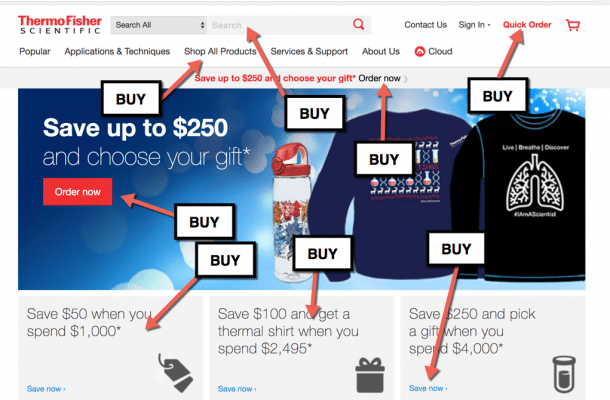
The adherence to conversion optimization is obvious once it is pointed out.
So what did ThermoFisher do differently behind the scenes?
They almost certainly expanded their in-house digital marketing team and invested millions into A/B testing, conversion optimization, UX and analytics.
We can assume that their investment into conversion, UX and analytics has allowed them to make a massive ROI and scale up their ad spend, SEO and content marketing efforts.
After building 27 websites in 2017, we learned the 3 most important changes you need to make 3 most important changes you need to make on your life science website in 2018 if you want to compete digitally with some of the top life science companies.
3 Tips for Life Science Conversion Optimization:
-
- Set Up Accurate Conversion Tracking – Having great conversion tracking and attribution data allows you to have visibility on exactly which campaign or channel is generating the most return. Imagine if you knew exactly how much you were spending to acquire a customer, down to the cent. Imagine if you were given a report each week stating, “This month we spent $5,000 in advertising and made $20,000 in revenue.” Data like this allows you to take the guesswork out of marketing initiatives and is by far the biggest competitive advantage you can have against your competition.
- High-Converting Pages – After your conversion tracking is set up, invest time and resources into identifying a strategic flow that guides a user down a logical progression towards a conversion. Let’s take your home page for an example. In 3 seconds, does a new user know what you do? Then, does it capture interest, resonate your target audience’s problem, offer a compelling solution, provide proof that you’re the best and then invite them to take action? If it doesn’t, you are probably missing out on a steady stream of new leads and sales. If you want a more in-depth look at conversion optimization, check out our free Life Science Conversion Optimization Video Series here.
- Invest in Your Search Bar – [Only for E-Commerce Websites] If you are a life science e-commerce website, your search bar is your most important feature on the entire website. Customers want to find what they are looking for as quickly as possible. If your search bar is hidden, not functioning or is not displaying common search terms as the end user searches, then you are probably losing a ton of potential customers.
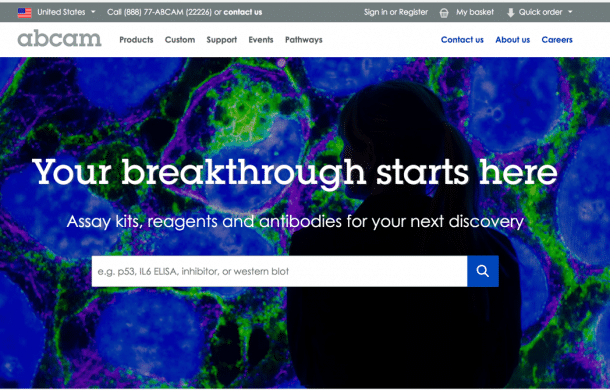
We admire Abcam’s utilization of their search bar.
They are the kings of Search Engine Marketing and they realize that their search bar isn’t everything… it’s the only thing.
Abcam’s website satisfies the #1 most important quality of a website, which is “users can find what they are searching for.”
When it comes to digital marketing, early adopters win.
Lucky for you, the life science industry is about 5 years behind in digital marketing.
Finally, as of last year, we saw a boom in awareness about just how important having an incredible website that serves as the #1 sales and marketing tool really is.
The top life science companies are scaling back on-the-ground sales reps and scaling up their digital presence and it’s paying off greatly.
Whether it is helping your sales team nurture and generate new leads, helping paid advertising perform better at a lower cost per acquisition or increasing organic traffic on the website through SEO and content marketing, your website is the central point for almost every online and offline marketing campaign.
Bottom line — If you have to cut budgets, then cut them on things that worked in the past like trade shows, sales teams and distributor relationships, just don’t cut corners on your future by neglecting to invest in your digital presence.
Lesson 5: 70% Content/30% Selling
You know that friend who only calls you when they need something?
Don’t be like that friend.
In 2017, we found the formula of 70% Content/30% Selling to be the most effective when doing content marketing.
In other words: Stop Selling. Start Giving.
Of course, if you get a new lead who is interested in your products or services, then it is absolutely okay to try and get them on a call. Just don’t beat them over the head tirelessly asking for a call for the next 2 weeks.
I can tell you that the vast majority of our customers have come from people who have gotten value from our LinkedIn/Blog posts, our Free 82-Step Life Science SEO Checklist or our Conversion Optimization Video Series.
Give your followers/prospects value and you will profit.
We recommend 70% content and 30% selling.
In other words, as long as you’re giving your prospects a ton of good content, they won’t get mad about you asking them to visit your website or fill out a contact form.
In the spirit of our 2018 marketing initiatives reflecting our 2017 lessons learned, we are going to be sharing all of our top secrets from our marketing team.
Over the next few weeks we are going to share our best tips for how we plan to have a successful 2018 for our clients in the life science industry.
Here is some of the information you can expect:
- How to find out what keywords your competitors are targeting, how much they are spending and tips on how you can beat them
- How to find out if yourcompetitors are using your trademarks in advertising to make money and how you can stop them (this is more common than you think)
- How to do life science SEO effectively on a budget
- Why people hate agencies, and a checklist you can use to make sure you don’t get burned by one
- How to optimize your website to make website visitors take action
- A free, downloadable landing page template we use to increase lead generation on paid traffic campaigns
If you are interested in subscribing to our Life Science Marketing bi-weekly newsletter, then shoot me at email and I will add you to our list.
Looking forward to kicking butt with you in 2018.
Sincerely,
Sheldon Zhai
P.S. What worked well for you in 2017? What was a challenge in 2017? What are your marketing goals for 2018? Leave a comment below.
Related Posts
Get a Quote or Ask a Question
- Curious about our process or pricing?
- Need help getting buy-in?
Contact us right away — we’d love to help.
Let’s take a look at your website together and figure out your best options for business growth.

Contact us right away — we’d love to help.
Let’s take a look at your website together and figure out your best options for business growth.

